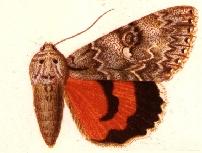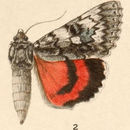Conservation Status
provided by University of Alberta Museums
A common, widespread species. No concerns.
- license
- cc-by-nc
- copyright
- University of Alberta Museums
Cyclicity
provided by University of Alberta Museums
Adults are on the wing from late July through mid-September.
- license
- cc-by-nc
- copyright
- University of Alberta Museums
Distribution
provided by University of Alberta Museums
From Nova Scotia south to Maine; west across Canada to British Columbia, and southward in the mountains. In Alberta, it is most abundant in the Aspen Parklands and across the southern Boreal Forest region, north to at least Lac la Biche and the northern Peace River area. It is also common throughout the foothills and in the lower elevations of the mountains, in the Cypress Hills, and in the wooded portions of the valleys of the arid Grasslands region.
- license
- cc-by-nc
- copyright
- University of Alberta Museums
General Description
provided by University of Alberta Museums
A large underwing moth (6.5-7.5 cm. wingspan) with mottled grey or mottled black, white and grey forewings and pink hindwings. In Alberta, semirelicta has two forms. The normal eastern form is less common here. It has black and white forewings with a broad black streak running along the fold, and is easy to recognize. This is the form usually illustrated in popular books. The normal form in Alberta is the much duller form "atala", which has powdery light and dark grey forewings with the jagged antemedian and sinuous postmedian lines marked in black. The large reniform spot and the surrounding area form an additional contrasting dark splotch. The narrow jagged subterminal line is indistinctly marked with pale scales. There are a few brown scales in the orbicular and along the postmedian line. The hindwings are dull pink or dark orange-pink. The black median band stops short of the margin. There are a few dark hairs, and the hindwings have a sharp, clean appearance. The hindwing fringe is white, and the antennae are simple. Both sexes are alike. Alberta semirelicta can be quite variable, and have gone under more than one name in the past. Some smaller specimens can be very difficult to separate from some C. hermia and C. meskei.
- license
- cc-by-nc
- copyright
- University of Alberta Museums
Habitat
provided by University of Alberta Museums
Mature Poplar and mixedwood forest, urban areas.
- license
- cc-by-nc
- copyright
- University of Alberta Museums
Life Cycle
provided by University of Alberta Museums
The adults, which fly in late summer and early fall, are nocturnal and come to light, but like all underwings, are most abundant at sugar bait. The eggs overwinter, and the larvae, which hatch in spring, are solitary defoliators. There is a single brood each year.
- license
- cc-by-nc
- copyright
- University of Alberta Museums
Trophic Strategy
provided by University of Alberta Museums
No Alberta data. Elsewhere poplars (Populus).
- license
- cc-by-nc
- copyright
- University of Alberta Museums
Catocala semirelicta
provided by wikipedia EN
Catocala semirelicta, the semirelict underwing, is a moth of the family Erebidae. The species was first described by Augustus Radcliffe Grote in 1874.[1] It is found in North America from Nevada, Colorado, Utah, California, and Nova Scotia south to Maine, west across Canada to British Columbia, and southward in the mountains.
The length of the forewings is about 30 mm. The wingspan is 65–75 mm.
Adults are on wing from July to September in one generation depending on the location. The larvae feed on Populus balsamifera, Populus tremuloides, and Salix species. There is probably one generation per year.
Subspecies
The latter is sometimes considered a distinct species.
References

- license
- cc-by-sa-3.0
- copyright
- Wikipedia authors and editors
Catocala semirelicta: Brief Summary
provided by wikipedia EN
Catocala semirelicta, the semirelict underwing, is a moth of the family Erebidae. The species was first described by Augustus Radcliffe Grote in 1874. It is found in North America from Nevada, Colorado, Utah, California, and Nova Scotia south to Maine, west across Canada to British Columbia, and southward in the mountains.

Illustration
The length of the forewings is about 30 mm. The wingspan is 65–75 mm.
Adults are on wing from July to September in one generation depending on the location. The larvae feed on Populus balsamifera, Populus tremuloides, and Salix species. There is probably one generation per year.
- license
- cc-by-sa-3.0
- copyright
- Wikipedia authors and editors

